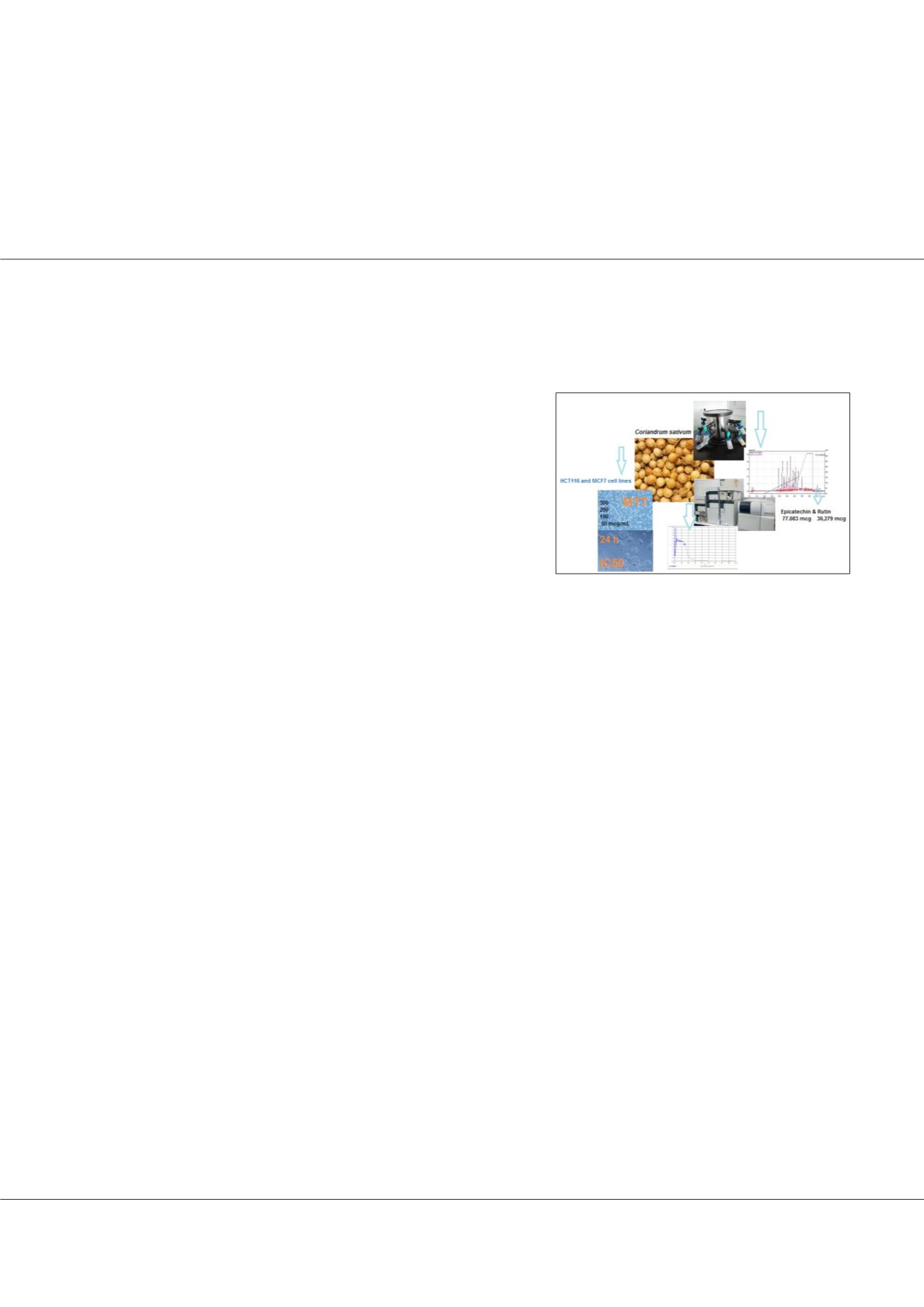

Page 73
conferenceseries
.com
Volume 4
Toxicology: Open Access
ISSN: 2476-2067
Toxicology Congress 2018
March 12-14, 2018
March 12-14, 2018 Singapore
14
th
World Congress on
Toxicology and Pharmacology
The anti-proliferative activity of
Coriandrum sativum
alcoholic extract on HCT-116 and MCF-7 cell lines
Eugenia Dumitrescu
1
, Florin Muselin
1
, Roxana Popescu
2
, Tulcan Camelia
1
, Andreia Chirila
1
and Romeo T Cristina
1
1
Banat’s University of Agriculture and Veterinary Medicine, Romania
2
Univesity of Medicine and Pharmacy, Romania
Statement of the Problem:
It is known that vegetal extracts can generate
positive responses in stages of several patho-processes. The anti-oxidant;
protection against DNA damage and cancer activities of
Coriandrum
sativum
were intensely studied in the last decade. Our research envisaged
the polyphenolic compounds’ structure and the anti-proliferative biologic
activity of
C. sativum
10% alcoholic extract against HCT-116 and MCF-7
cell lines.
Methodology:
The
C. sativum
extract was obtained respecting the Romanian
Pharmacopoeia 10
th
edition, the plant being lyophilized (with Ilshin
Kryptonstraat 11, 6718WR EBE lyophilisator to -55 oC, 5 mTorr pressure
and 24 hours lyophilization time). The polyphenols were determined by LC-MS and the
in vitro
evaluation effects by the MTT
proliferation test, using HCT116 (colorectal carcinoma) and MCF7 (mammary adenocarcinoma). The cells were seed as: 2×10
4
(MCF7) and 1×10
4
(HCT) in 96 well plates. The lyophilized extracts were suspended in specific culture medium being obtained
a 300 mg/mL
C. sativum
stock solution. From this, different test concentrations were prepared by dilution (300, 200, 100 and
respectively 50 mcg/mL).
Result & Conclusion:
As a following, after 24 hours from the exposure, using HCT-116 and MCF-7 cell lines it was observed
that the cellular proliferation reduced, this being correlated to dose and the alterations of cell morphology to the groups studied;
to great extract doses, apoptotic and necrotic alterations were observed, both for HCT and MCF cells; the IC50, representing
concentration to which a marker substance is reducing the tissues viability with 50% after a fixed time exposure period wasn’t
observed for the cell lines used in this test; the chromatographic analysis of
C. sativum
alcoholic extract evidenced the presence
of the polyphenolic compounds, the greatest concentrations were ascertained for epicatechin (77.083 mcg/mL) and rutin
(30.279 mcg/mL), substances with known hard anti-oxidant proprieties.
References
1. Rayar A, Manivannan R (2015)
In Vitro
Cytotoxicity Activity of Phytochemicals Isolated from
Coriandrum sativum Linn
.
in Selected Cell Lines.
Journal of Pharmacy and Biological Sciences
; 10(3): 38-48.
2. AL Snafi A E (2014) The Pharmacological importance and chemical constituents of
Arctium lappa
: A review.
International
Journal for Pharmaceutical Research Scholars
; 3(1-1): 663-670.
3. Kumar R S, Balasubramanian P, Govindaraj P, Krishnaveni T (2014) Preliminary studies on phytochemicals and
antimicrobial activity of solvent extracts of
Coriandrum sativum L.
roots (Coriander).
Journal of Pharmacognosy and
Phytochemistry
; 2(6): 74-78.
4. Nithya T G, Sumalatha D (2014) Evaluation of
in vitro
anti-oxidant and anticancer activity of
Coriandrum sativum
against
human colon cancer HT-29 cell lines.
International Journal of Pharmacology and Pharmacy Science
; 6(2): 421-424.
5. Tang E L, Rajarajeswaran J, Fung S Y, Kanthimathi M S (2013) Antioxidant activity of
Coriandrum sativum
and protection
against DNA damage and cancer cell migration.
BMC Complementary and Alternative Medicine
; 13: 347.
Biography
Eugenia Dumitrescu has her expertise in the veterinary field, reproductive toxicology, heavy metals, phyto-therapy and oxidative stress in animals. She is an
Associate Professor at the Faculty of Veterinary Medicine at Banat’s University of Agriculture and Veterinary Medicine, Romania.
cris_tinab@yahoo.comEugenia Dumitrescu et al., Toxicol Open Access 2018, Volume 4
DOI: 10.4172/2476-2067-C1-006
















